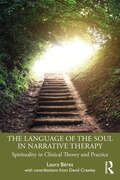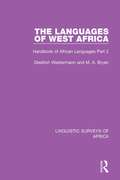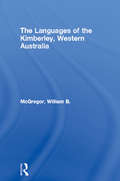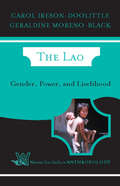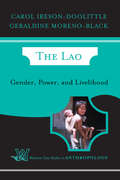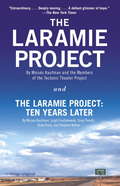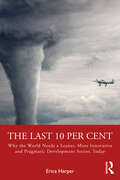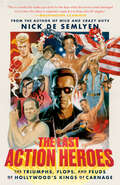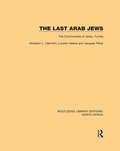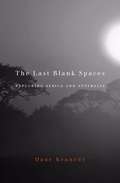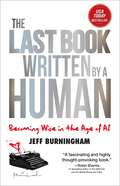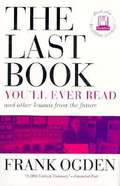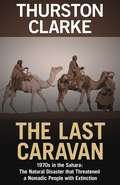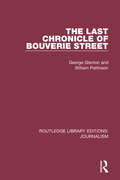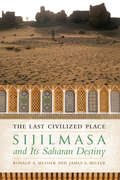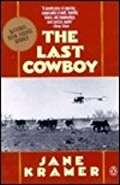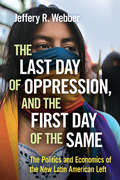- Table View
- List View
The Language of the Soul in Narrative Therapy: Spirituality in Clinical Theory and Practice
by Laura BéresThe Language of the Soul in Narrative Therapy uniquely bridges the gap between narrative therapy and spirituality to describe how the theory and practice of narrative therapy may be expanded and enriched by incorporating the language of the soul. Divided into three parts, the book begins by contextualizing the approach of narrative therapy and spirituality. Chapters then debate the complexity of the ‘soul’ as a term drawing on the work of Christian mystics and philosophers, such as Teresa of Avila, Edith Stein, Merleau-Ponty, and Bakhtin, to show how their theoretical ideas can be incorporated in counseling practice and spiritual direction. The book concludes by discussing how the language of the soul can be integrated and applied in postmodern practice. With case examples from faith belief systems, such as Christianity, Buddhism, Paganism, Wicca, and Yazidism, throughout, this book is essential reading for therapists, clinical social workers, and counsellors in practice and graduate training, as well as spiritual directors and pastoral counselors interested in the ideas and practices of narrative therapy.
The Languages of West Africa: Handbook of African Languages Part 2 (Linguistic Surveys of Africa #14)
by M. A. Bryan Diedrich WestermannThis volume, originally published in 1970, presents a survey of the languages spoken in an area extending from the Atlantic coast at the Sengal River eastward to the Lake Chad region. The area covered by this volume is mainly a goegraphical one, so it follows that not all the languages included are related to one another, though a certain degree of homogeneity appears.
The Languages of the Kimberley, Western Australia
by William B. McGregorThe Kimberley, the far north-west of Australia, is one of the most linguistically diverse regions of the continent. Some fifty-five Aboriginal languages belonging to five different families are spoken within its borders. Few of these languages are currently being passed on to children, most of whom speak Kriol (a new language that arose about half a century ago from an earlier Pidgin English) or Aboriginal English (a dialect of English) as their mother tongue and usual language of communication. This book describes the Aboriginal languages spoken today and in the recent past in this region.
The Lao
by Carol Ireson-Doolittle Geraldine Moreno-BlackThe Lao discusses culture and village life in Laos, exploring topics of kinship and family, gender relations, households, religion, livelihood strategies, and ethnicity. In particular, the effects of recent development projects on the relative power of men and women in rural Lao society, and the responses of women to those changes, are highlighted. Ireson-Doolittle and Moreno-Black not only provide a description of life on the ground but also explore how local affairs are connected to the wider world, and how the Lao people preserve traditions while also responding to change.
The Lao: Gender, Power, And Livelihood (Case Studies in Anthropology)
by Carol Ireson-DoolittleThe Lao discusses culture and village life in Laos, exploring topics of kinship and family, gender relations, households, religion, livelihood strategies, and ethnicity. In particular, it highlights the effects of recent development projects on the relative power of men and women in rural Lao society, and the responses of women to those changes. I
The Laramie Project and The Laramie Project: Ten Years Later
by Moises Kaufman Andy Paris Tectonic Theater Project Greg Pierotti Leigh FondakowskiOn October 7, 1998, a young gay man was discovered bound to a fence outside Laramie, Wyoming, savagely beaten and left to die in an act of brutality and hate that shocked the nation. Matthew Shepard’s death became a national symbol of intolerance, but for the people of the town, the event was deeply personal. In the aftermath, Moisés Kaufman and members of the Tectonic Theater Project went to Laramie and conducted more than 200 interviews with its citizens. From the transcripts, the playwrights constructed an extraordinary chronicle of life in the town after the murder. Since its premiere, The Laramie Project has become a modern classic and one of the most-performed theater pieces in America. <P> Now, in this expanded edition, The Laramie Project: Ten Years Later adds an essential sequel to the original work. Revisiting the town a decade after the tragedy, the troupe finds a community grappling with its legacy and its place in history. The two plays together comprise an epic and deeply moving theatrical cycle that explores the life of an American town over the course a decade.
The Last 10 Per Cent: Why the World Needs a Leaner, More Innovative and Pragmatic Development Sector, Today
by Erica HarperCriticism that the development sector has not delivered in terms of eliminating extreme poverty, fast-tracking growth and preventing conflict, is neither new nor surprising. In fact, it may be the one thing that scholars, donors and practitioners agree on. While many of these concerns are valid, this book makes a case that the sector is closer to unlocking the gates to more effective and efficient development outcomes than is popularly believed. Specifically, it argues that by overturning a few myths, making better use of evidence and employing some different rules, practitioners, policy specialists and donors can foster the changes in the development architecture that are needed to reach the 10 percent of the world’s population still living in extreme poverty. Engaging, provocative and clear sighted, the book provides insight into interventions around democratic governance, refugee response, counterterrorism, gender mainstreaming, environmental protection and private sector engagement. It is instructive reading for professionals across the development sector, think tanks and NGOs.
The Last Action Heroes: The Triumphs, Flops, and Feuds of Hollywood's Kings of Carnage
by Nick de SemlyenThe behind-the-scenes story of the action heroes who ruled 1980s and &’90s Hollywood and the beloved films that made them stars, including Die Hard, First Blood, The Terminator, and more.&“This book takes you so close to the action that you can smell the sweat, cigar smoke, and bad cologne that brought these movies to life.&”—Paul ScheerThe Last Action Heroes opens in May 1990 in Cannes, with Arnold Schwarzenegger and Sylvester Stallone waltzing together, cheered on by a crowd of famous faces. After years of bitter combat—Stallone once threw a bowl of flowers at Schwarzenegger&’s head, and the body count in Schwarzenegger&’s Commando was increased so the film would &“have a bigger dick than Rambo&”—the world&’s biggest action stars have at last made peace.In this wildly entertaining account of the golden age of the action movie, Nick de Semlyen charts Stallone and Schwarzenegger&’s carnage-packed journey from enmity to friendship against the backdrop of Reagan&’s America and the Cold War. He also reveals fascinating untold stories of the colorful characters who ascended in their wake: high-kickers Chuck Norris and Jackie Chan, glowering tough guys Dolph Lundgren and Steven Seagal, and quipping troublemakers Jean-Claude Van Damme and Bruce Willis. But as time rolled on, the era of the invincible action hero who used muscle, martial arts, or the perfect weapon to save the day began to fade. When Jurassic Park trounced Schwarzenegger&’s Last Action Hero in 1993, the glory days of these macho men—and the vision of masculinity they celebrated—were officially over.Drawing on candid interviews with the action stars themselves, plus their collaborators, friends, and foes, The Last Action Heroes is a no-holds-barred account of a period in Hollywood history when there were no limits to the heights of fame these men achieved, or to the mayhem they wrought, on-screen and off.
The Last Arab Jews: The Communities of Jerba, Tunisia (Routledge Library Editions: North Africa #4)
by Abraham L. Udovitch Lucette Valensi Jacques PerezThe once numerous and vital Jewish communities of Morocco, Algeria and Tunisia have disappeared, succumbing during the past century to the assimilating temptations of French culture, or, more recently, to the pressures of migration. Only the two communities of the island of Jerba still remain. Only they have succeeded in maintaining and reproducing their religious and social institutions, in adjusting to the new realities around them while preserving intact their cultural, communal identity. This lavishly-illustrated book, first published in 1984, portrays the life and history of two Jerban Jewish villages and explores the paradoxes of their continuity. <P><P>How and why are they so fully Jewish while, at the same time, so thoroughly embedded in their Muslim, North African environment? Although its focus is one small ethnic group, the implications of this study extend to the broad subject of relations between Arabs and Jews in modern times.
The Last Blank Spaces
by Dane KennedyThe challenge of opening Africa and Australia to British imperial influence fell to a coterie of proto-professional explorers who sought knowledge, adventure, and fame but often experienced confusion, fear, and failure. The Last Blank Spaces follows the arc of these explorations, from idea to practice, intention to outcome, myth to reality.
The Last Book Written by a Human: Becoming Wise in the Age of AI
by Jeff BurninghamIn The Last Book Written by a Human, tech entrepreneur Jeff Burningham delivers a profound and urgent exploration of what it truly means to be human in the age of AI—challenging us to embrace wisdom, love, and deep human connection as we navigate an uncertain future alongside machines."A refreshingly optimistic look at the possibilities of human-AI interaction." --Kirkus ReviewsWhat does it mean to be human? At a time when AI is rapidly changing the way we live, work, and think, this may be the biggest question we face. In The Last Book Written by a Human, tech entrepreneur and investor Jeff Burningham wrestles with the fundamental questions of existence, the future role of artificial intelligence in society, and the increasingly complex union between humanity and its creations. With raw honesty, Burningham shares his personal story from Mormon missionary and Bishop to successful entrepreneur to his gubernatorial run and beyond, offering reflections on our otherworldly potential and uncertain future in the age of AI. His call to action is clear: As machines become smarter, we must become wiser. You will discover: * How the rise of AI is forcing humanity to confront fundamental questions about consciousness, intelligence, and what it means to be truly human. * Why the development of AI must be guided by love, wisdom, and compassion. * How to navigate relationships in the future, ensuring we maintain genuine human connection alongside increasingly synthetic ones. * The importance of reforming institutions—religious, governmental, and business—to support human flourishing. * The cosmic necessity of mastering your life as a human being, rather than a human doing. This book is a wake-up call for our species to evolve beyond our unconscious patterns, false beliefs, and outdated systems in order to thrive in the age of AI.
The Last Book You'll Ever Read and Other Lessons from the Future
by Frank Ogden"The only constant is change. Learn to love it. As the rate of change accelerates, the result will appear chaotic to the uninitiated. But there is elegant order in chaos. Few so far have learned to recognize and profit from it. This is where the future lies."<P> From his houseboat moored in Vancouver harbor — a floating electronic cottage — Frank Ogden monitors the world by computer phone link and satellite dish. His boundless curiosity, his gift for extrapolation, and his ability to synthesize information have made him one of the world's foremost futurists.<P> A consultant to corporations, professional organizations, and government agencies, he is in constant demand as a catalyst of change, stimulating his clients to think creatively about the future and their place in it.<P> Ogden has led a life of profitable nonconformity. Born in Toronto, he was educated in Canada and the United States before serving as a flight engineer in the Second World War. He has since done everything from selling airplanes to joining a team of therapists researching LSD at Hollywood Hospital. He helped establish Canada's first think-tank, was a founding member of the World Future Society in Canada, and in 1989 was elected a Fellow of the Explorers Club in New York.<P> Today Frank Ogden travels the world tirelessly, fascinated as ever by the process of change, seeking out the latest trends, and thinking about where they're leading us. How will the technological revolution affect the way we live? What will the Information Age ultimately mean for the "knows" and the "know-nots"? Is the next millennium to be feared or embraced?<P> Draw from his popular seminars and syndicated "Dr. Tomorrow" newspaper column, The Last Book You'll Ever Read is a sampling of the provocative insights and useful predictions that have made Frank Ogden, in the words of the Los Angeles Times, "possibly the world's most up-to-date futurist."
The Last Caravan: 1970s in the Sahara: The Natural Disaster that Threatened a Nomadic People with Extinction
by Thurston ClarkeThe Last Caravan is a powerful and dramatic account of how the great African drought of the early 1970s transformed the nomadic Tuareg, the famous blue-veiled men of the Beau Geste legend. Thurston Clarke recounts their story in his words and theirs, allowing them to come to life as they describe their sufferings and wanderings in search of food and comfort. Their story is a powerful one of ecological disaster, of the courage and nobility of an ancient people facing extinction, and of the struggle to preserve their families and way of life.
The Last Chronicle of Bouverie Street: On The Closure Of The News Chronicle And The Star (Routledge Library Editions: Journalism #7)
by George Glenton William PattinsonOriginally published in 1963. This book tells the story of the closure of the News Chronicle and its London evening companion The Star as seen by two journalists on the News Chronicle. They describe the Daily News tradition, record some of its finest hours and write about some of the greatest journalists who served their employers loyally. They endeavour to unravel what went on in Bouverie Street immediately before, at the moment of the crash and afterwards. The merger of these two prominent organs of public opinion with the Daily Mail and Evening News made splash headlines and was widely discussed in the press, on television and radio. Faithful readers were dismayed, politicians were alarmed, and the staff of the newspapers were indignant. For 114 years the Daily News and its modern successor the News Chronicle had weathered financial storms and overcome gales of prejudice and political opinion to become one of the most respected morning papers. The Star had, since 1888, fought the cause of the underdog and earned the affection and gratitude of many Londoners. This book highlights the feelings of men and women who were proud to work for their paper but did not know till almost the very last that they were fighting a losing battle, and how and why some of them kept the secret.
The Last Civilized Place: Sijilmasa and Its Saharan Destiny
by James A. Miller Ronald A. MessierSet along the Sahara&’s edge, Sijilmasa was an African El Dorado, a legendary city of gold. But unlike El Dorado, Sijilmasa was a real city, the pivot in the gold trade between ancient Ghana and the Mediterranean world. Following its emergence as an independent city-state controlling a monopoly on gold during its first 250 years, Sijilmasa was incorporated into empire—Almoravid, Almohad, and onward—leading to the &“last civilized place&” becoming the cradle of today&’s Moroccan dynasty, the Alaouites. Sijilmasa&’s millennium of greatness ebbed with periods of war, renewal, and abandonment. Today, its ruins lie adjacent to and under the modern town of Rissani, bypassed by time. The Moroccan-American Project at Sijilmasa draws on archaeology, historical texts, field reconnaissance, oral tradition, and legend to weave the story of how this fabled city mastered its fate. The authors&’ deep local knowledge and interpretation of the written and ecological record allow them to describe how people and place molded four distinct periods in the city&’s history. Messier and Miller compare models of Islamic cities to what they found on the ground to understand how Sijilmasa functioned as a city. Continuities and discontinuities between Sijilmasa and the contemporary landscape sharpen questions regarding the nature of human life on the rim of the desert. What, they ask, allows places like Sijilmasa to rise to greatness? What causes them to fall away and disappear into the desert sands?
The Last Cowboy
by Jane KramerPortrays the life of a man who strives to be "a proper cowboy" despite radical changes which have propelled the Old West into a New Southwest characterized by industrialized agribusiness.<P><P> 'The West that Henry mourned belonged to the Western movie, where the land and the cattle went to their proper guardians and brought a fortune in respect and power. It was a West where the best cowboy got to shoot the meanest outlaw, woo the prettiest schoolteacher, bed her briefly to produce sons, and then ignore her for the finer company of other cowboys - a West as sentimental and as brutal as the people who made a virtue of that curious combination of qualities and called it the American experience.' From the Introduction: Henry Blanton is the 'last cowboy' of Jane Kramer's classic portrait, the failed hero of his own mythology, the man who ends an era for himself. His story - his flawed, funny, and in the end tragic efforts to be a proper cowboy, 'expressin' right' in a world where the range is a feed yard and college boys run ranches from air-conditioned Buicks -is the story of a country coming of age in great promise and greater disappointment. A hundred and fifty miles up the highway from agri-business Amarillo, Henry claimed the extravagant prerogatives of a free man on a horse. He rode his own frontier, decked out in his vigilance and his honour, until the shocking moment when in the person of Henry Blanton the West and the Western had a showdown.<P> Winner of the National Book Award
The Last Day of Oppression, and the First Day of the Same: The Politics and Economics of the New Latin American Left
by Jeffery R. WebberThroughout the 2000s Latin America transformed itself into the leading edge of anti-neoliberal resistance in the world. What is left of the Pink Tide today? What is their relationship to the explosive social movements that propelled them to power? As China's demand slackens for Latin American commodities, will governments continue to rely on natural resource extraction? In an accessible and penetrating volume, Jeffery Webber examines the most important questions facing the Latin American left today.
The Last Days in Israel: Understanding the New Israeli Democracy (Israeli History, Politics and Society #No. 26)
by Abraham DiskinDuring the 1990s many dramatic changes influenced the basic characteristics of the Israeli democracy. This volume examines the challenges and circumstances the country has faced and addresses both the public's and leadership's singular goal of "peace and security". The book also investigates the renewed constitutional framework which attempted to meet new challenges, but in reality contributed to the evolution of "new politics" and a new party system. This new system is explored through an analytical study of the history of the party system with an emphasis on new phenomena, such as the growing fragmentation of recent years. Developments since the early 1990s are also examined, looking at the governmental periods of Prime Ministers: Shamir, Rabin, Peres, Netanyahu and Barak.
The Last Days of Stalin
by Joshua RubensteinA gripping account of the months before and after Joseph Stalin’s death and how his demise reshaped the course of twentieth-century history.Joshua Rubenstein’s riveting account takes us back to the second half of 1952 when no one could foresee an end to Joseph Stalin’s murderous regime. He was poised to challenge the newly elected U.S. President Dwight Eisenhower with armed force, and was also broadening a vicious campaign against Soviet Jews. Stalin’s sudden collapse and death in March 1953 was as dramatic and mysterious as his life. It is no overstatement to say that his passing marked a major turning point in the twentieth century.The Last Days of Stalin is an engaging, briskly told account of the dictator’s final active months, the vigil at his deathbed, and the unfolding of Soviet and international events in the months after his death. Rubenstein throws fresh light onthe devious plotting of Beria, Malenkov, Khrushchev, and other “comrades in arms” who well understood the significance of the dictator’s impending death;the witness-documented events of his death as compared to official published versions;Stalin’s rumored plans to forcibly exile Soviet Jews;the responses of Eisenhower and Secretary of State Dulles to the Kremlin’s conciliatory gestures after Stalin’s death; andthe momentous repercussions when Stalin’s regime of terror was cut short.“A fascinating and often chilling reconstruction of the months surrounding the Soviet dictator’s death.” —Saul David, Evening Standard (UK)“A gripping look at the power struggles after the Red Tsar’s death.” —Victor Sebestyen, The Sunday Times (UK)“Stalin’s death in March 1953 cut short another spasm of blood purges he was planning, but triggered only limited Soviet reforms. To some Westerners it promised an extended period of peace, but others feared it would leave the West even more vulnerable. Joshua Rubenstein’s lively, detailed, carefully crafted book chronicles a key twentieth-century turning point that didn’t entirely turn, revealing what difference Stalin’s death did and didn’t make and why.” —William Taubman, author of Khrushchev: The Man and His Era
The Last Days of Sylvia Plath
by Carl RollysonIn her last days, Sylvia Plath struggled to break out from the control of the towering figure of her husband Ted Hughes. In the antique mythology of his retinue, she had become the gorgon threatening to bring down the House of Hughes. Drawing on recently available court records, archives, and interviews, and reevaluating the memoirs of the formidable Hughes contingent who treated Plath as a female hysteric, Carl Rollyson rehabilitates the image of a woman too often viewed solely within the confines of what Hughes and his collaborators wanted to be written. Rollyson is the first biographer to gain access to the papers of Ruth Tiffany Barnhouse at Smith College, a key figure in the poet’s final days. Barnhouse was a therapist who may have been the only person to whom Plath believed she could reveal her whole self. Barnhouse went beyond the protocols of her profession, serving more as Plath’s ally, seeking a way out of the imprisoning charisma of Ted Hughes and friends he counted on to support a regime of antipathy against her. The Last Days of Sylvia Plath focuses on the train of events that plagued Plath’s last seven months when she tried to recover her own life in the midst of Hughes’s alternating threats and reassurances. In a siege-like atmosphere a tormented Plath continued to write, reach out to friends, and care for her two children. Why Barnhouse seemed, in Hughes’s malign view, his wife’s undoing, and how biographers, Hughes, and his cohort parsed the events that led to the poet’s death, form the charged and contentious story this book has to tell.
The Last Deployment: How a Gay, Hammer-Swinging Twentysomething Survived a Year in Iraq
by Bronson LemerIn 2003, after serving five and a half years as a carpenter in a North Dakota National Guard engineer unit, Bronson Lemer was ready to leave the military behind. But six months short of completing his commitment to the army, Lemer was deployed on a yearlong tour of duty to Iraq. Leaving college life behind in the Midwest, he yearns for a lost love and quietly dreams of a future as an openly gay man outside the military. He discovers that his father’s lifelong example of silent strength has taught him much about being a man, and these lessons help him survive in a war zone and to conceal his sexuality, as he is required to do by the U.S. military. The Last Deployment is a moving, provocative chronicle of one soldier’s struggle to reconcile military brotherhood with self-acceptance. Lemer captures the absurd nuances of a soldier’s daily life: growing a mustache to disguise his fear, wearing pantyhose to battle sand fleas, and exchanging barbs with Iraqis while driving through Baghdad. But most strikingly, he describes the poignant reality faced by gay servicemen and servicewomen, who must mask their identities while serving a country that disowns them. Often funny, sometimes anguished, The Last Deployment paints a deeply personal portrait of war in the twenty-first century.
The Last Door: A History of Torture in Mexico's War against Subversives (Violence in Latin American History)
by Gladys I. McCormickAs guerrilla groups sprouted up across Mexico in the early 1970s, the military and police routinely resorted to extreme acts of violence, including the systematic use of torture. In The Last Door, Gladys McCormick provides the most thorough account of how torture became a crucial and routine practice of the Mexican government’s war against subversives. Drawing from extensive oral history interviews and declassified government documents, McCormick describes experiences of arrest, torture, and detention in which forced disappearances became all too common and advocates for justice rallied around political prisoners. Torture was not always about extracting information; it was also about inflicting punishment on a faceless so-called enemy and instilling terror into advocates of social change. As McCormick argues, torture became a quotidian practice of state making in Mexico during the 1970s, leaving individuals and their families forever changed. The lack of repercussions for government officials notorious for employing torture, even in spite of a growing movement for truth and justice, has led to entrenched impunity that is endemic in Mexico as its contemporary security crisis continues.
The Last Editor: How I Saved the New York Times, the Washington Post, and the Los Angeles Times from Dullness and Complacency
by Jim BellowsThe innovative newspaper editor chronicles his storied career in this memoir, featuring sidebars from the like of Tom Wolfe, Katherine Graham, and more.The Last Editor is the memoir of Jim Bellows, the editor whose David-and-Goliath battles changed the face of the newspaper business. Bellows struggled to save major competitors of America’s three most powerful newspapers: the New York Times, the Washington Post, and the Los Angeles Times. In doing so, he developed major talent from rough cuts and brought a new generation of writers to the mainstream press.The Last Editor is a unique memoir of a man who loved a fight—highlighted with commentary from his colleagues in letters and sidebars from the biggest names in media. Sidebars from Tom Wolfe, Ben Bradlee, Art Buchwald, Katherine Graham, Mary McGrory, William Safire, just to name a few, and 16 pages of black-and-white photos, provide behind-the-scenes insights to the triumphs and controversies of the man who shaped the industry.“This is a lively, engaging recollection of the glory days of newspapers with amusing stories of the fabled men and women of journalism at a time when many American cities supported at least two newspapers.” —Booklist
The Last Energy War: The Battle Over Utility Deregulation (Open Media Series)
by Harvey WassermanA fast-paced, shoot-from-the-hip "people's history," The Last Energy War is an accessible, entertaining, and infuriating narration of how the electric power business started, how it almost bankrupted the nation, and how it is now soaking the public to pay for its trillion-dollar atomic mistake.From the electric chair to Chernobyl, from Thomas Edison to Cleveland's "boy mayor" Dennis Kucinich, this fascinating little book shows how the mega-utilities squashed solar power, how a military-utility alliance helped force atomic reactors down the public throat without a vote, and how a score of bought state legislatures have already handed corrupt utilities $200 billion in pure pork through a bogus deregulatory process.Merciless in its Robber Baron critique, The Last Energy War also builds on American heroes such as Franklin Roosevelt and George Norris to offer a blueprint for how we can take back out power supply.Relentlessly optimistic, it is the one book you must read to understand what's really happening to you when you turn on your lights--and then get the bill.
The Last Englishman: The Life of J.L. Carr
by Byron RogersA biography of the English educator, dictionary writer, and celebrated author of A Month in the Country.J.L. Carr was the most English of Englishmen: headmaster of a Northamptonshire school, cricket enthusiast and campaigner for the conservation of country churches. But he was also the author of half a dozen utterly unique novels, including his masterpiece, A Month in the Country, and a publisher of some of the most eccentric—and smallest—books ever printed.Byron Roger’s acclaimed biography reveals an elusive, quixotic and civic-minded individual with an unswerving sympathy for the underdog, who led his schoolchildren through the streets to hymn the beauty of the cherry trees and paved his garden path with the printing plates for his hand-drawn maps, and whose fiction is quite remarkably autobiographical. Much more than the life of a thoroughly decent man, The Last Englishman is a comic and touching anatomy of the best kind of Englishness.Praise for The Last Englishman“A miniature masterpiece of social history.” —Simon Jenkins, The Times (UK)“A fine biography. . . . Rogers has done a wonderful job.” —Daily Telegraph (UK)“Conveying the significance of the author of Carr’s Dictionary of Extraordinary Cricketers to anyone unfamiliar with his books, or what may now fairly be called his myth, was always going to be difficult. Somehow, Roger’s has managed it.” —D. J. Taylor, Sunday Times (UK)“A great success, and more life-affirming than F. R. Leavis’s entire output.” —Independent on Sunday (UK)
